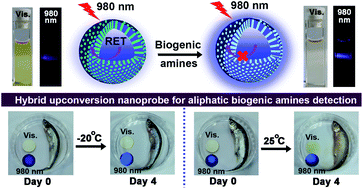A hybrid upconversion nanoprobe for ratiometric detection of aliphatic biogenic amines in aqueous medium†
Abstract
We fabricated an inorganic–organic hybrid upconversion nanoprobe for the ratiometric detection of aliphatic biogenic amines in water. The hybrid nanoprobe comprises a thiophene-based acceptor–π-donor–π-acceptor organic fluorescent dye, TDPM, and near-infrared light-absorbing upconversion nanoparticles (UCNPs). The organic dye was loaded into a mesoporous silica-coated UCNP (UCNP@mSiO2) matrix to circumvent the issues of water insolubility and higher energy excitation. Yb3+ and Tm3+-doped UCNPs exhibited dual emission bands at 475 and 645 nm upon excitation with a 980 nm laser. The significant spectral overlap between the absorption and the emission bands of TDPM and UCNPs, respectively, at 475 nm led to resonance energy transfer (RET) from the UCNPs to TDPM resulting in the quenching of the UCNP emission. In contrast, ‘turn-on’ emission was noticeable with the addition of aliphatic biogenic amines due to an inhibition of the RET. The emission at 645 nm remained unaffected during the energy transfer process making the hybrid probe a versatile platform for the ratiometric detection of different aliphatic biogenic amines. Furthermore, we explored the sensing of aliphatic biogenic amines in adulterated milk and rotten fish. The unique material attributes demonstrated in the current study hold promise for further development of real-time sensors and switches based on hybrid upconversion nanoprobes.



 Please wait while we load your content...
Please wait while we load your content...